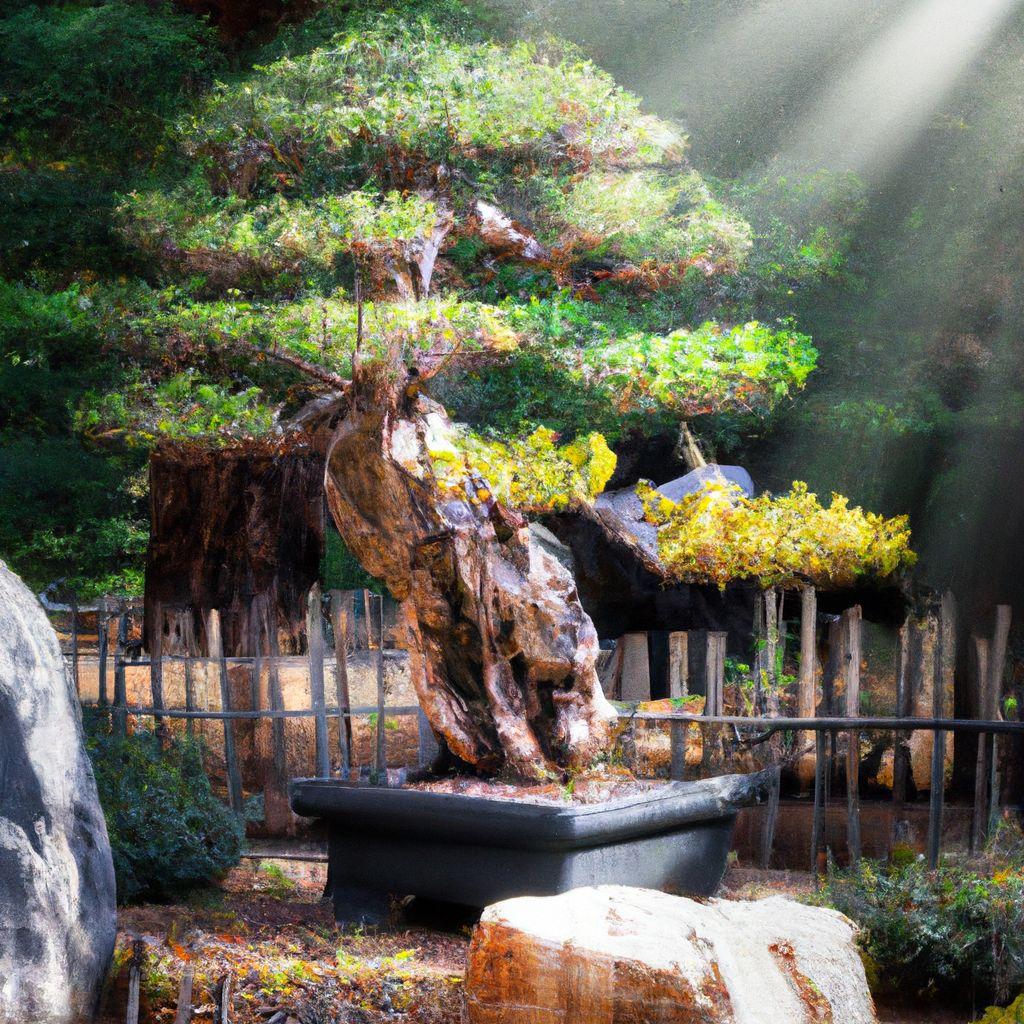Key takeaway:
- Formal Upright Bonsai gardening is an art form that involves cultivating miniature trees in a formal upright style, originating from the traditional Japanese practice of bonsai.
- Choosing the right tree species is crucial for creating a successful Formal Upright Bonsai. Coniferous trees like Juniper, Pine, and Spruce are ideal choices, while other species with slightly wavy trunks like Japanese Maple, Trident Maple, Pomegranate, Beech, and Crab Apple can also be considered.
- Pruning and shaping the trunk and branches are essential techniques in creating a Formal Upright Bonsai. Regular pruning and tapering of the trunk are important for maintaining the desired appearance, while achieving a “Christmas tree” silhouette with lower branches and a straight, tapered trunk is a key characteristic of this style.
Introduction to Formal Upright Bonsai Gardening
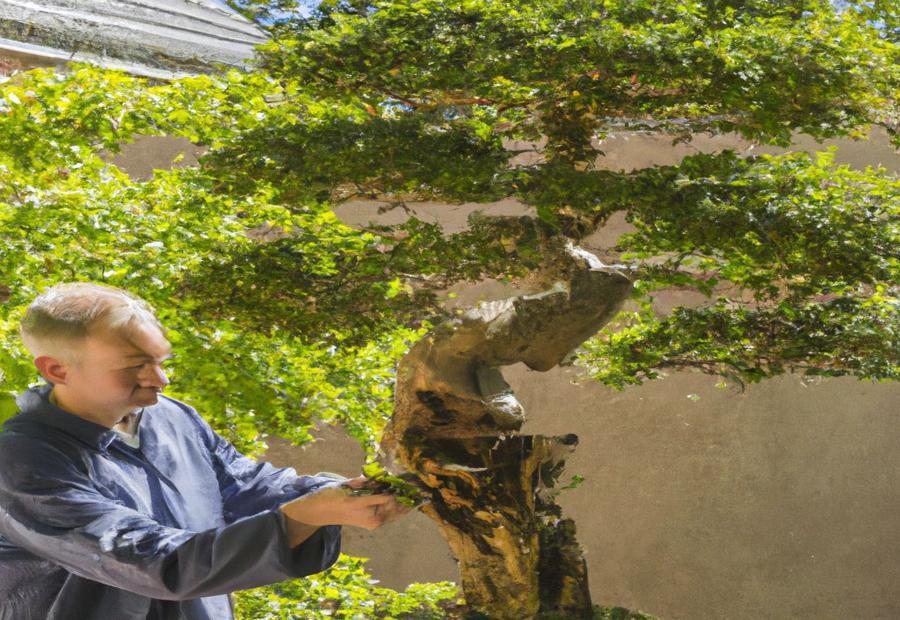
Photo Credits: Gardeninggurus.Org by Ralph Clark
Formal Upright Bonsai Gardening invites us into the world of exquisite miniature trees. Delve into the captivating origins and concept of bonsai, as well as the distinctive characteristics of the Formal Upright style. Discover the artistry and precision that goes into shaping these living sculptures, creating a harmonious and visually striking representation of nature in your own garden.
Explanation of the concept of bonsai and its origins
Bonsai, a Japanese art form that’s thousands of years old, is cultivating miniature trees in containers. This ancient practice started in China. Then, the Japanese refined and developed various styles and techniques. The concept of bonsai is making a small, proportionate representation of nature in a pleasing way. It symbolizes harmony between man and nature, and the fleeting beauty of life.
The Formal Upright style of bonsai is a classic and recognizable shape. It has a straight trunk that tapers from the base to the top, with branches in a symmetrical pattern. This style looks like a mature tree standing tall and proud. It gives a feeling of strength, stability, and elegance.
To get the desired Formal Upright shape, coniferous trees like Juniper, Pine, and Spruce are ideal. These trees have naturally straight trunks. But, other species like Japanese Maple, Trident Maple, Pomegranate, Beech, and Crab Apple can be used if they’ve got slightly wavy trunks that can be trained.
Making a Formal Upright bonsai needs specific pruning and shaping. Pruning is important to keep the right proportions and encourage the right branching patterns. Tapering the trunk is essential for the Formal Upright look. Also, the lower branches should be arranged like those on a Christmas tree.
To maintain a Formal Upright bonsai, placement and position are important. Planting it closer to one side of the container creates asymmetry and interest. Larger and lower branches should go at the bottom. Shorter branches should be towards the middle and top. Examples of properly placed branches can help.
For Formal Upright bonsai, rotating the tree to get even sun exposure is important. Choosing the right tree species with the desired shape saves time and effort. Techniques for maintaining slanting branches can give age and character.
Introduction to the Formal Upright style and its characteristics
Formal Upright Bonsai Gardening is an exquisite art. It has roots in China and Japan, where it was a form of meditation. Its focus is on harmony and balance.
Trees like Juniper, Pine, and Spruce are best for this style. They keep their shape. Species with wavy trunks like Japanese Maple, Trident Maple, Pomegranate, Beech, and Crab Apple can also work. They bring unique characteristics to the tree.
Pruning and shaping are key. Trimming creates a tapered, “Christmas tree” appearance. Placement is important, too. Put the tree to one side of the container for stability. Position branches in three sections – bottom, middle, and top – for interest. Place them to get sunlight. Make sure they fit the overall form.
Rotate bonsai trees for even sun exposure. Prune branches to add age and character. Select the right species for your desired trunk shape. Formal Upright Bonsai is like finding the perfect partner. Compatible with a bit of pruning!
Choosing the Right Species for Formal Upright Bonsai
When it comes to creating a formal upright bonsai, choosing the right tree species is essential. In this section, we will explore the best tree species that perfectly fit the formal upright style. Discover the unique characteristics and qualities of these species, allowing you to make an informed decision in your bonsai gardening journey. So, let’s dive into the world of bonsai trees and find the perfect match for creating stunning formal upright compositions.
The best tree species for Formal Upright style
Coniferous trees, like Juniper, Pine and Spruce, are ideal for the Formal Upright bonsai style. They have a straight trunk, compact foliage, and an elegant look. But others, such as Japanese Maple, Trident Maple, Pomegranate, Beech, and Crab Apple, are great too. These offer more options. Each tree brings its own character to the bonsai. It’s all about artistic expression and personal preference.
The tree species you choose will affect the success of your Formal Upright bonsai. Think about trunk shape, growth patterns, and leaf structure. Pick the right tree and your bonsai will be stunning. Herb Markowitz’s foemina juniper bonsai is a great example. This tree has an upright growth habit and small needles, making it perfect for the Formal Upright style. With care and training, Herb Markowitz was able to create a masterpiece.
Transform your garden into a mini-forest. Choose coniferous species for the perfect bonsai!
Coniferous trees like Juniper, Pine, and Spruce as ideal choices
Juniper, Pine, and Spruce, coniferous trees, are a great choice for the Formal Upright style of bonsai gardening. These species possess key features to make a visually-appealing and aesthetically-pleasing bonsai.
- Juniper: Delicate foliage and graceful looks make Juniper perfect. It easily takes pruning and shaping for a straight and tapered trunk.
- Pine: Long needles and cones provide a unique charm. Its tough growth habit makes it ideal for a straight trunk with less effort.
- Spruce: Compact foliage and elegant form make Spruce a favorite. Its branches can be styled for a balanced design.
These trees bring maturity, grace, and elegance to the Formal Upright bonsai style. Their growth patterns let enthusiasts create strong trunks with symmetry and precision. Pruning and maintaining these trees in this style leads to stunning results that show artistry and horticultural skill.
Other species with slightly wavy trunks like Japanese Maple, Trident Maple, Pomegranate, Beech, and Crab Apple
For a formal upright bonsai style, species like Japanese Maple, Trident Maple, Pomegranate, Beech, and Crab Apple are ideal picks! These trees have natural features that are perfect for this type of gardening.
The Japanese Maple has graceful branches and vibrant foliage, perfect for a formal upright bonsai. Trident Maple has a unique bark and gorgeous fall colors. Pomegranate trees have artistic trunks with twisting branches. Beech trees have smooth bark and attractive foliage. Finally, Crab Apples have eye-catching branch formations and stunning blossoms.
These species with slightly wavy trunks offer bonsai enthusiasts many options for creating unique and captivating designs in the formal upright style. However, they require pruning and shaping to keep their form. Regular maintenance is essential to properly display their slightly wavy trunks in the formal upright style. If taken care of correctly, these species can be beautiful formal upright bonsais in any garden or collection.
Experienced bonsai gardeners favor these species due to their qualities for the artform. So, get ready to make your trees bow down to your bonsai skills!
Techniques for Creating a Formal Upright Bonsai
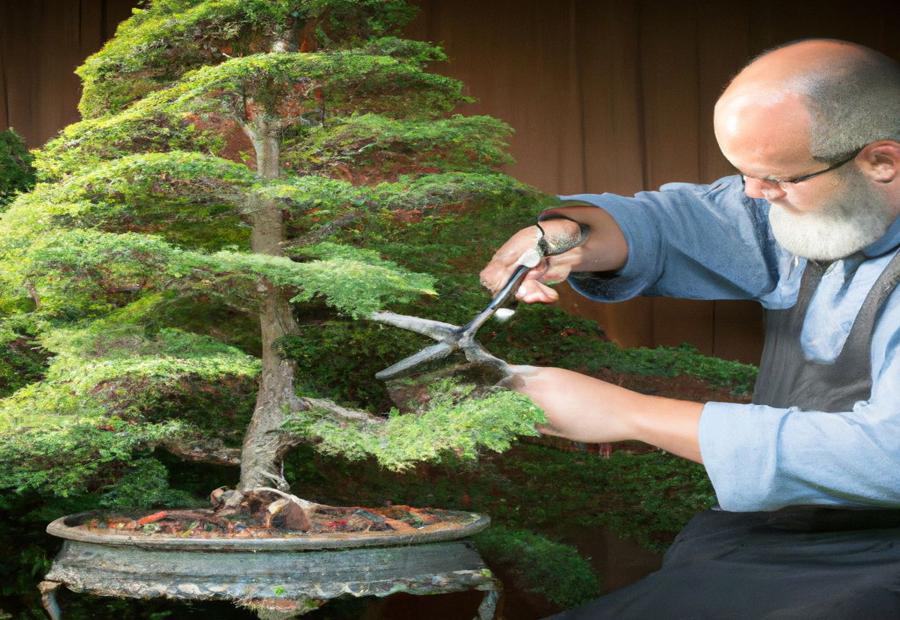
Photo Credits: Gardeninggurus.Org by Robert Green
Discover the art of creating a stunning formal upright bonsai through the techniques of pruning and shaping the trunk and branches. Unleash your creativity and learn how to sculpt these miniature trees into majestic works of art. With precise cuts and meticulous shaping, you’ll witness the transformation of a simple tree into a captivating masterpiece. Get ready to delve into the world of formal upright bonsai gardening and unlock the secrets to immaculate craftsmanship.
Pruning and Shaping the Trunk and Branches
Pruning and shaping the trunk and branches are must-dos for formal upright bonsai gardening. This lets bonsai enthusiasts create beautiful compositions. Regular pruning, tapering the trunk and getting a “Christmas tree” outline with lower branches are well-known. Here’s a 4-step guide:
- Prune branches regularly to get balanced growth and the desired shape. Get rid of any crossing branches.
- To get a tapered trunk, trim more at the top while allowing lower branches to grow. It resembles the natural growth pattern of mature trees.
- Prune lower branches slightly longer than the upper branches to give a “Christmas tree” look.
- Prune the main trunk upwards, creating a graceful, tapered line from bottom to top.
Plus, use wiring for shaping the trunk and branches. Wrap wire around young, flexible shoots or twigs to guide them into the desired positions.
Also, rotate the bonsai tree outdoors to give equal sun exposure and avoid imbalances in growth.
In summary, trimming and shaping bonsai is like getting a hair cut, but without the complaints. These practices are key for keeping the desired look of the bonsai.
Importance of regular pruning and tapering the trunk
Regular pruning and tapering are essential for formal upright bonsai gardening. These practices help create a visually pleasing and well-proportioned tree. Pruning allows for control over growth and direction, as well as refinement of the bonsai. Selective pruning can add movement and character to the trunk.
Tapering the trunk is another must-do. This mimics the growth patterns of mature trees in nature, resulting in a more attractive design. Larger branches should be pruned closer to the base and smaller ones near the top should be allowed to grow freely. This encourages Formal Upright Bonsai Gardening’s apical dominance, making the nutrients flow towards the upper part of the tree.
In conclusion, regular pruning and tapering are vital for formal upright bonsai gardening. They help maintain the size and shape, as well as create a more aesthetically pleasing tree. Incorporating these techniques is key to crafting one’s own miniature work of art.
Achieving a “Christmas tree” appearance with lower branches
- Prune and shape the trunk and branches selectively. This helps to create an open structure and get sunlight everywhere.
- Make the trunk taper. Do this by reducing its thickness from bottom to top.
- Set the branches properly. Lower branches should be longer and wider than higher ones. This gives the appearance of different layers.
To enhance the tree’s look, put it closer to one side of its container. This adds interest and mimics natural growth.
Use wiring to place and shape branches differently. This way, you will get the classic “Christmas Tree” look.
Creating a straight and tapered trunk with regular pruning
Creating a straight and tapered trunk with regular pruning is a major part of formal upright bonsai gardening. Trimming back new growth and guiding the trunk to grow straight is key to this. Here’s a 4-step guide to help you:
- Check the trunk’s current shape and remove any unwanted branches.
- Make precise cuts with bonsai shears, aiming for balance.
- Keep trimming and directing the trunk to be straight and tapered.
- Observe the results, making changes as needed.
By following these steps, you can get a visually pleasing bonsai tree with a straight trunk that tapers up. Also, proper branch placement helps create a “Christmas tree” look.
Interestingly, this technique has been used for centuries in traditional Japanese bonsai artistry. Skilled artists observe carefully to make exquisite specimens that show balance and elegance. Formal bonsai is like a symphony – each branch and leaf is important for harmony.
Maintaining Formal Upright Bonsai
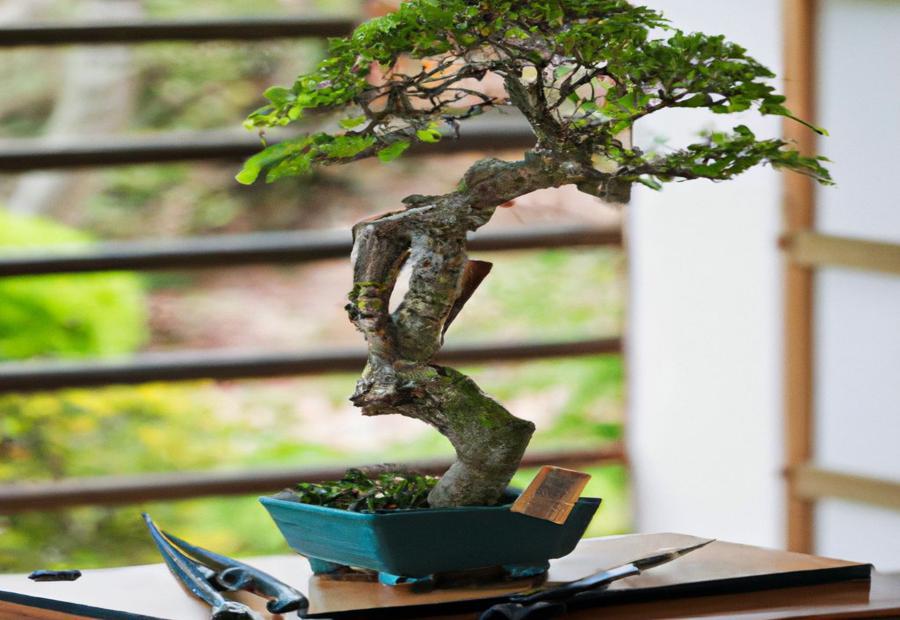
Photo Credits: Gardeninggurus.Org by Zachary Brown
When it comes to maintaining formal upright bonsai, positioning and placement play a crucial role. Understanding how to position and place these delicate miniature trees can make all the difference in their growth and overall aesthetic appeal. In this section, we will explore the essential aspects of positioning and placement in formal upright bonsai gardening, providing insights on how to best showcase and care for these captivating creations.
Positioning and Placement
For ideal positioning and placement in bonsai gardening, plant the tree closer to one side of the container. This asymmetrical placement makes the composition more dynamic. When positioning branches, consider their placement towards the bottom, middle, and top of the tree. This provides depth and dimension to the bonsai.
Examples of proper placement exist. For example, Juniper, Pine, and Spruce should have branches at various heights. Japanese Maple, Trident Maple, Pomegranate, Beech, and Crab Apple can be placed to emphasize their unique curves.
By following these tips for formal upright bonsai gardening, enthusiasts can create compositions with balance and harmony.
Planting the tree closer to the side of the container
- For a neat, balanced bonsai look, prune off any extra branches or foliage.
- When repotting, take care not to damage the roots when taking the tree out of its pot.
- Select an appropriate-sized container.
- Put a layer of bonsai soil at the bottom.
- Position the tree, leaning it slightly to one side. This asymmetry gives the tree naturalness and interest.
- Add more soil around the roots. Gently press down to provide stability.
- Planting closer to one side of the container makes for an aesthetically pleasing Formal Upright style.
- Pruning, repotting, and placement of the tree – all these techniques come together to create a beautiful bonsai.
Proper positioning of branches towards the bottom, middle, and top
Positioning branches at the bottom, middle, and top is essential for a great Formal Upright bonsai. Placing branches at different levels creates balance and harmony.
The bottom branches provide stability and form the foundation. They are usually larger and more horizontal.
The middle branches add depth and movement. They create a sense of growth and visual appeal.
The top branches, called the “apex,” are smaller and delicate. They add refinement and elegance.
Every bonsai artist has their own approach to branch placement. The goal is to create a design with balance, harmony, and beauty. It helps to study examples from experienced bonsai artists.
Choosing the right branch placement is like finding the perfect seat at a concert. It’s all about the best view and vibe that blend together.
Examples of properly placed branches
For a Formal Upright Bonsai to look its best, the branches must be placed in the right spot. This style follows certain rules to make the bonsai appealing.
To understand where to place branches, look at the chosen tree species and their growth. Each tree has its own traits that show how the branches should be arranged for a nice composition.
For example, if the tree is planted near the side of the pot, put branches at the bottom, middle, and top for balance and depth. Pruning and shaping can make the trunk straight and slender with branches evenly spaced.
By studying these examples, one can learn how to properly place branches in Formal Upright Bonsai Gardening.
Tips and Tricks for Formal Upright Bonsai Gardening

Photo Credits: Gardeninggurus.Org by Jason Hill
In the realm of formal upright bonsai gardening, mastering a few tips and tricks can make all the difference. From ensuring even sun exposure through regular tree rotation to selecting the perfect tree species for desired trunk shapes, and maintaining slanting branches to add character and age, this section is packed with invaluable insights to enhance your skills and achieve stunning results. Get ready to delve into the world of formal upright bonsai gardening with these expert techniques.
Importance of rotating bonsai trees for even sun exposure
Rotating bonsai trees is essential. It ensures each side gets equal sun exposure. This prevents uneven growth and helps the tree stay healthy. It encourages balanced photosynthesis and gives all branches energy for growth.
Rotation also helps the tree stay symmetrical. Sunlight guides its growth pattern. When you rotate, each side gets the same amount of light. This keeps foliage and branch structure in balance.
Rotating also helps with issues caused by uneven sun exposure. Weak or stunted growth can happen on some sides. But, when you rotate regularly, these problems fade or go away. You end up with a healthier, beautiful tree.
For proper rotation, mark one side of the pot. Use a small sticker or colored tape. This helps you remember which side was last facing the sun. Rotating consistently gives the tree even sun exposure. This leads to well-rounded growth and vitality.
Tips for choosing the right species of tree for a desired trunk shape
For formal upright bonsai gardening, picking the right species of tree is key. Juniper, Pine, and Spruce are great for creating straight and tapered trunks. Japanese Maple, Trident Maple, Pomegranate, Beech, and Crab Apple can also be used to achieve specific trunk shapes.
Take note of natural growth patterns and characteristics of different trees. The species you pick should fit your desired trunk shape. Coniferous trees give a traditional formal upright look. Trees with wavy trunks add movement and energy.
Seek advice from experienced growers or check reference materials about each variety. This will help you pick a species that will thrive and complement your design.
For added character, slanted branches are like having an unruly relative at family gatherings.
Techniques for maintaining slanting branches for added age and character
To maintain slanted branches in formal upright bonsai gardening, several techniques are utilized. These techniques work together to create an aged and artistic composition, adding depth and telling a story.
1. Pruning: Cutting off excess growth is essential for shaping the tree’s structure and encouraging the growth of slanted branches.
2. Wiring: By gently bending and shaping the branches with wire, their growth can be guided to achieve the desired slanting effect.
3. Gravity: Positioning certain branches at angles that give in to the pull of gravity enhances the natural movement of the tree.
4. Maintenance Techniques: Regular monitoring and adjusting of branch positions ensure that the desired slanting effect is maintained.
5. Natural Environmental Factors: Exposure to wind and other elements can influence the movement of branches, further enhancing their natural appearance.
6. Branch Placement: Placing slanted branches strategically throughout the tree adds visual interest and creates a balanced composition.
These techniques, including pruning, wiring, utilizing gravity, applying maintenance techniques, considering natural environmental factors, and placing branches strategically, all contribute to the overall aesthetic and character of the tree in formal upright bonsai gardening.
Personal Stories and Inspirations
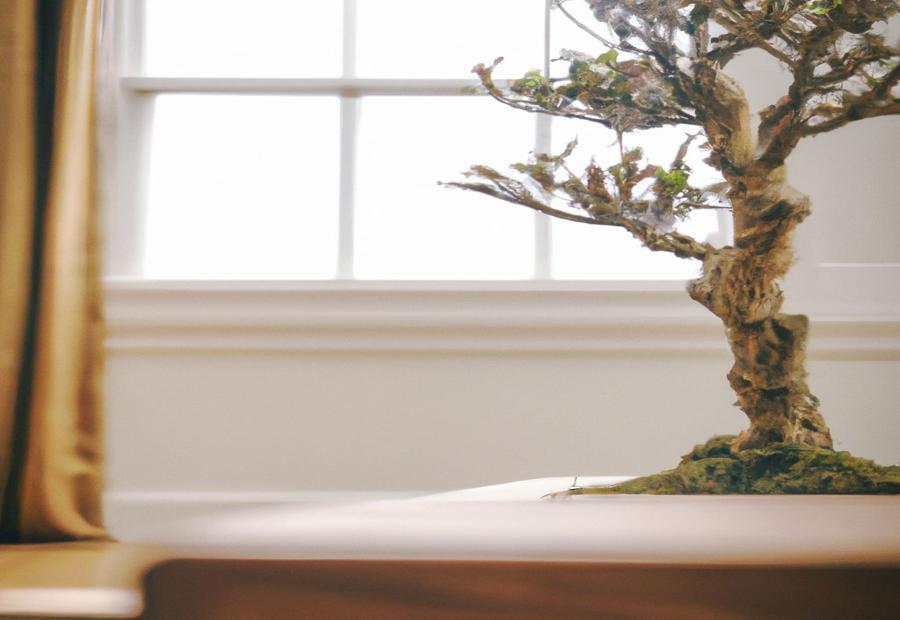
Photo Credits: Gardeninggurus.Org by Jeffrey Torres
In the realm of Formal Upright Bonsai Gardening, the Personal Stories and Inspirations section takes us on a journey. We get to delve into captivating narratives like Herb Markowitz’s accomplishments with his foemina juniper bonsai. Furthermore, we discover the significance of personal preference when it comes to choosing bonsai styles. These stories and insights will surely inspire and ignite a passion for the art of bonsai.
Sharing a personal story about Herb Markowitz and his foemina juniper bonsai
Herb Markowitz is a passionate bonsai gardener. He has a special story to share about his foemina juniper bonsai. He has invested years of care and skill, nurturing it into a stunning Formal Upright style. This personal tale serves as a reminder of the art and expertise involved in bonsai gardening.
Herb’s journey with his foemina juniper bonsai illustrates the meticulous techniques needed for a Formal Upright masterpiece. He regularly prunes and shapes the trunk and branches. This creates a “Christmas tree” look with tapered lower branches. He also prunes the trunk to create a straight and tapered shape, capturing the Formal Upright style.
A unique detail that stands out about Herb’s foemina juniper bonsai is its positioning and placement in the container. Planting it closer to one side emphasizes its upright nature while still maintaining balance and harmony. Carefully placed branches at the bottom, middle, and top enhance this sense of perfection.
Herb’s story is inspiring as it gives a glimpse into the world of bonsai gardening. We get to see the dedication and passion that goes into creating a work of art. It encourages us to explore our creativity and pursue our passions in this timeless art form.
So why not start your own bonsai journey? Be inspired by Herb’s story and use it to fuel your desire to create beauty in the Formal Upright style. Don’t miss out on the joy of nurturing these living sculptures that bring life and tranquility into your surroundings. Begin your path towards mastering this art form today!
Emphasizing the importance of personal preference in bonsai styles
Personal preference is essential in the bonsai world. It’s an art that lets people show their creativity through the cultivation and shaping of miniature trees. The Formal Upright style offers a structured look. But, when deciding on a bonsai tree, personal preference should always be taken into account.
When it comes to bonsai styling, what counts is personal preference. Each individual has their own aesthetic taste. The Formal Upright style may be suitable for someone who likes structure. But, those with a preference for wilder trees may opt for Informal Upright or Literati.
Personal preference permits people to show their uniqueness through bonsai gardening. They can create trees that reflect their individual taste and vision. From the tree species to the positioning of branches, personal preferences direct all decisions.
By embracing personal preference, people open themselves up to endless possibilities. Each person’s unique taste adds depth and diversity to the art form. So why limit oneself to only one style? Experiment and let personal preference be the guide.
Bonsai trees tell a story – of the creator’s passion for nature and aesthetics. Trust your instincts and follow your own artistic journey. Formal Upright Bonsai Gardening: Where trees stay stylish, even in miniature form.
Conclusion
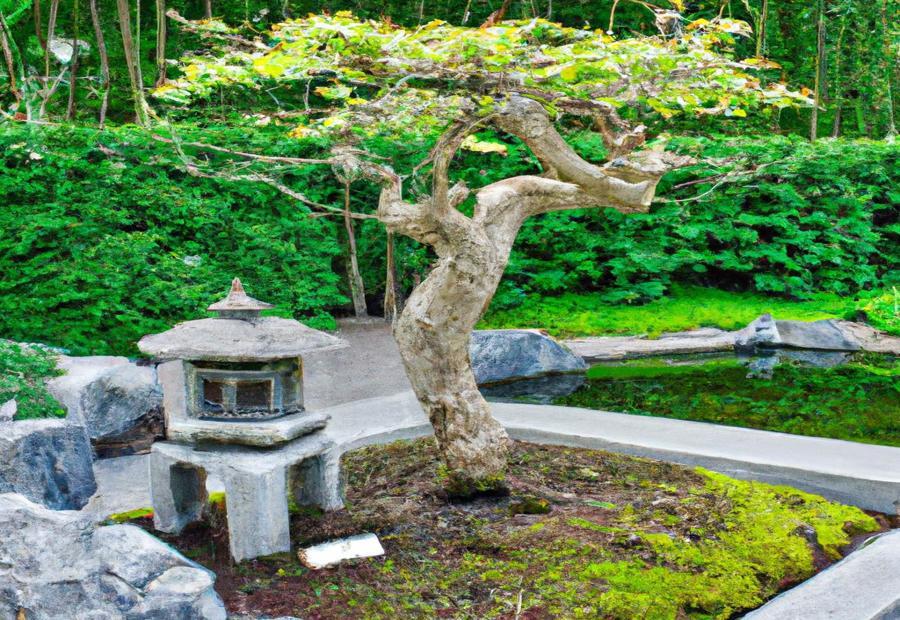
Photo Credits: Gardeninggurus.Org by Samuel Baker
In conclusion, let’s recap the distinctive features of the Formal Upright style in bonsai gardening and be encouraged to explore the profound beauty and artistic essence it brings. By understanding the foundations and techniques of this style, we can create stunning bonsai masterpieces that capture the harmony of nature within a confined space. So, let’s embrace the artistry of bonsai gardening and embark on a journey of creativity and tranquility.
Recap of the Formal Upright style and its features
Formal Upright bonsai is a traditional style which focuses on a straight, tapered trunk and branches that descend in size. It is commonly used with coniferous trees like Juniper, Pine, and Spruce. But, other species like Japanese Maple and Beech can also be used. An important feature is the even spacing of branches, with lower ones being thicker and top ones thinner. The overall shape is triangular or pyramidal.
The proper positioning and placement of the tree within its container is very important. It should be closer to one side of the container. Regular rotation of the bonsai helps ensure even sun exposure. To get a stunning display, choose a species with unique characteristics that show off its trunk shape.
Formal Upright bonsai gardening is an art form that celebrates the natural growth of trees. Pruning, shaping, and positioning all come together to create a harmonious and captivating display.
Encouragement for readers to explore the beauty and artistry of bonsai gardening.
Bonsai gardening invites you to explore the world of art and beauty. Discover the complex techniques and designs used to create these miniature trees. The Formal Upright style stands out with its majestic, straight trunks and well-positioned branches. This style symbolizes bonsai gardening, motivating enthusiasts to embrace its artistic charm.
Those interested in the Formal Upright style must choose the right tree species. Coniferous trees like Juniper, Pine, and Spruce are ideal for this style. Japanese Maple, Trident Maple, Pomegranate, Beech, and Crab Apple are also good options, as they have slightly wavy trunks.
To make a Formal Upright bonsai, you need to master pruning and shaping techniques. Prune the trunk to make it tall and slender like a Christmas tree. Cut the branches to cascade downwards, while still keeping the trunk straight and tapered.
Ensure that your bonsai is properly positioned and placed. Place the tree closer to one side of the container. Position the branches towards the bottom, middle, and top. This will create visual harmony throughout the tree structure.
You must pay attention to more than just aesthetics when doing bonsai gardening. Rotate the bonsai trees regularly to ensure even sun exposure. Pick tree species with desired trunk shapes and maintain slanting branches to enhance the age and character of your Formal Upright bonsai.
Each bonsai gardener has their own unique journey and inspirations. Herb Markowitz’s foemina juniper bonsai story is a testament to their passion. Personal preferences help you decide which style to choose, allowing you to express your artistry through this exquisite form of gardening.
So, experience the beauty and artistry of bonsai gardening. The Formal Upright style offers the chance to immerse yourself in this calming practice and make visually captivating miniature trees.
Some Facts About Formal Upright Bonsai Gardening:
- ✅ The Formal Upright style in bonsai resembles full-grown trees with a tapering trunk and decreasingly spaced branches. (Source: Team Research)
- ✅ The Formal Upright style is best suited for coniferous trees like Juniper, Pine, and Spruce. (Source: Team Research)
- ✅ Lower branches are pruned in the Formal Upright style to achieve a “Christmas tree” appearance, with top branches being the smallest. (Source: Team Research)
- ✅ The trunk in the Formal Upright style takes years to perfect through regular pruning to achieve a desired tapering effect. (Source: Team Research)
- ✅ Occasionally, the tree in the Formal Upright style is planted closer to the side of the container instead of the center. (Source: Team Research)
FAQs about Formal Upright Bonsai Gardening
What are the major styles of bonsai trees?
The major styles of bonsai trees include the Formal Upright style and the Informal Upright style.
How does the Formal Upright style in bonsai trees resemble full-grown trees?
The Formal Upright style in bonsai trees resembles full-grown trees with a tapering trunk and decreasingly spaced branches.
Which types of trees are best suited for the Formal Upright style?
Coniferous trees like Juniper, Pine, and Spruce are best suited for the Formal Upright style in bonsai trees.
What is the technique used to achieve a “Christmas tree” appearance in the Formal Upright style?
In the Formal Upright style, lower branches are pruned to achieve a “Christmas tree” appearance, with top branches being the smallest.
How is the Informal Upright style different from the Formal Upright style?
The Informal Upright style is a more relaxed version of the Formal Upright style, allowing for a slightly bent or slanted trunk.
Which tree species are suitable for the Informal Upright style?
The Informal Upright style can be used with coniferous trees, as well as species with slightly wavy trunks like Japanese Maple, Trident Maple, Pomegranate, Beech, and Crab Apple.


